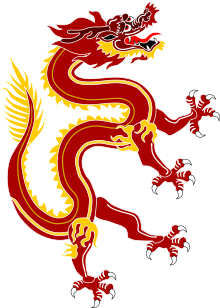User:DragonSign
Welcome all to the dragon lair!

Terminology from Buddhism
Narashanda - male to female transsexual
Narishanda - female to male transsexual
Tritiya-prakriti - third gender
Homosexuality and transgenderism in Chinese history
Depictions of homosexuality have been found in archaeological evidence dating from the Liu Song dynasty .[1] Buddhism and other eastern views generally views issues relating to procreation as inferior to a life of celibacy and this concept can explain the view of eastern religions on homosexuality vs homosexual sex.[2]
Buddhism considers marriage to be a secular issue or a social contract, and therefore not a religious matter.[3] There is no religious marriage service or marriage customs are often adopted from local cultural traditions, for example with Andi Fian arguing that prohibitions against homosexual marriage in Confucianism may have influenced Chinese Buddhism.[4][5]
Ancient writings in both Buddhist and Hindu texts found throughout South Asia and South East Asia refer to two types of tritiya-prakriti (literally third gender)[6]: Narshanda are male to female transgenders; Narishanda are female to male transgenders.[7][8] References to transgenderism are found in spiritual texts throughout the Dharmic religions and furthermore in cultures that have been influenced by Indian thought.[9] Ancient medical literary works also describe transgenders at various stages of ancient history, including famously in the Kama Sutra.[10]
- ^ Ruan, F. F.; Tsai, Y. M. (1987). "Male homosexuality in traditional Chinese literature". Journal of Homosexuality. 14 (3–4): 21–33. doi:10.1300/J082v14n03_02. ISSN 0091-8369. PMID 3323308.
- ^ academic.oup.com https://academic.oup.com/book/28469/chapter-abstract/229097470?redirectedFrom=fulltext. Retrieved 2024-02-18.
{{cite web}}: Missing or empty|title=(help) - ^ "What Buddhism Teaches About Romantic Love and Marriage". Learn Religions. Retrieved 2024-01-24.
- ^ "Sexuality and gender". academic.oup.com. Retrieved 2024-01-24.
- ^ Fian, Andi (2 December 2022). "BUDDHISM AND CONFUCIANISM ON HOMOSEXUALITY: THE ACCEPTANCE AND REJECTION BASED ON THE ARGUMENTS OF RELIGIOUS TEXTS". Journal of Religious Studies. 3 (2). Sekolah Pascasarjana, Universitas Gadjah Mada: Center for Religious and Cross-cultural Studies (CRCS): 73–82 – via Phil.
- ^ Wilhelm, Amara Das (2008-11-15). Tritiya-Prakriti: People of the Third Sex: Understanding Homosexuality,Transgender Identity and Intersex Conditions Through Hinduism. Philadelphia, Pa: XLIBRIS. ISBN 978-1-4134-3534-4.
- ^ International Journal of Ayurveda and Pharma Research. 2021-10-16. doi:10.47070/ijapr.v9i9. ISSN 2322-0910 http://dx.doi.org/10.47070/ijapr.v9i9.
{{cite journal}}: Missing or empty|title=(help) - ^ SASP Hansitha, DPDN Kularathna. "A Comparative Literature Review of the Contribution of Transgender Rights in the Legal Context of India and Sri Lanka". Department of Legal Studies, Open University of Sri Lanka.
- ^ Bhava, Sakhi (2012-09-01). Transgender Spirituality: Man into Goddess. CreateSpace Independent Publishing Platform. ISBN 978-1-4792-3862-0.
- ^ academic.oup.com https://academic.oup.com/book/11527/chapter-abstract/160309396?redirectedFrom=fulltext. Retrieved 2024-02-12.
{{cite web}}: Missing or empty|title=(help)
